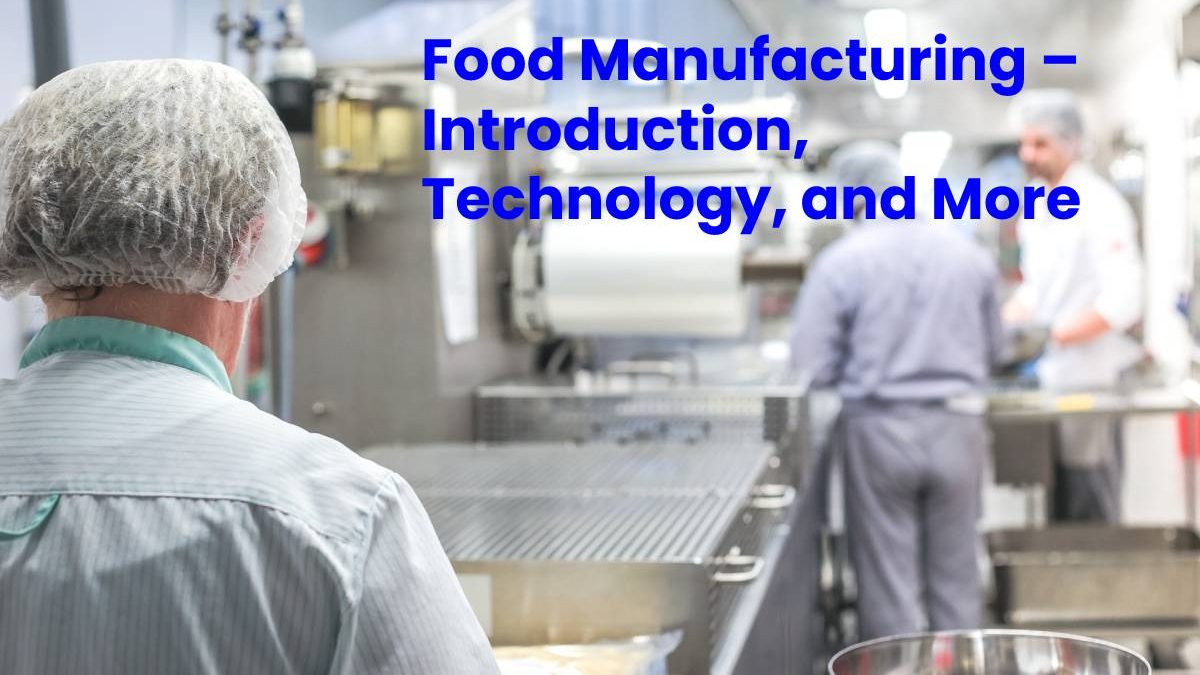Table of Contents
Introduction – Food Manufacturing
Food Manufacturing – Since ancient times, food making has been a popular way of producing convenient and accessible food. With companies like General Mills, Frito-Lay, and Tyson Foods, consumers can easily buy ready-made food at a local store. In fact, according to Industry Research, the processed food market will reach $ 5.9 trillion in 2019. And it is expected to reach $ 7.7 trillion by 2026. As more and more people consume ready-made products, it is essential to understand their processes.
What is Food Creation?
Food production refers to the conversion of raw materials into edible products. Companies in the food industry produce a wide range of packaged foods for consumers. For example, General Mills uses commodities such as wheat, oats, and sugar to make grain, desserts, and pet food. The food production value chain includes animal processing, including butchers and slaughterhouses. Here are the standard techniques that these companies use to process their products.
Cutting
For convenience, food producers cut or chop vegetables, produce, and meat for consumers. For example, they peel and pack peaches or chop raw meat and pack it. People can then save time and prepare meals faster.
Storage
Proper food preservation techniques maximise shelf life and preserve flavour. One way to keep meat, fruits, and vegetables is through dehydration, which involves removing moisture from the ingredient. Another method is to add salt or vinegar to the food to marinate it. Many companies are also known for their canned ingredients.
Flavoring
Firstly, preparing several products together can change their taste. That’s why manufacturers taste these foods to improve flavor profiles and quality.
Homogenization
Thus, This method relates to the use of fat globules, additives, and stabilizers to ensure that the components of a product are not separated. Homogenization is standard for salad dressings, cream, and milk.
Stages of Food Manufacturing/ Preparation
Many small businesses make food and sell it at farmers’ markets and grocery stores. However, the proper techniques must implement to succeed in the industry and connect with the target customers. Here are the main stages of food production.
1. Do Market and Industry Research – Food Manufacturing
Entrepreneurs should do industry and market research to better understand existing products and potential competitors. The study will also highlight the production cost and its practicality and demand. It allows for strategic brainstorming on how to increase profits and innovate.
2. Financial Supervision – Food Manufacturing
However, it is important to detail all the costs incurred by the company. It includes ingredients, packaging, labels, machinery, and distribution expenses. The owner can budget and find a suitable investment by determining the costs. Usually, companies raise money from personal finances or family and friends.
3. Create the Right Package – Food Manufacturing
Adequate product packaging conveys the company’s brand and attracts consumers to the object. With hundreds of other products on store shelves, the company needed a label that stood out. One way to create a unique and profitable package is to understand your target consumers.
4. Ensure Regulatory Compliance – Food Manufacturing
The Food and Drug Administration (FDA) has different regulations for each type of food. They also have product labelling policies. Small businesses need to make sure their ready-made stores comply with these federal and state regulations.
5. Protect the Product
As the brand begins to produce large quantities of food for the market, retailers may need to work with more people. Different people have access to brands’ products, ideas, and secret recipes. To prevent corporate information from being shared and reproduced.
6. Do you have Marketing Campaigns?
A successful marketing plan allows the brand to reach a wide range of customers. Businesses can develop effective marketing campaigns by conducting market research to discover customer preferences. It will help increase sales and overall profits.
Advantages of Food Manufacturing.
Food production is made easier and more accessible by providing food to a growing population. Other benefits for food manufacturing include the following factors.
Better quality control
Food producers must follow protocols to ensure cleanliness and quality. These processes involve cleaning storage spaces, cooking a diet at the right temperature, and using the proper packaging. It provides the integrity and taste of nutrition.
Guaranteed Food Safety Compliance
Along with quality control procedures, food producers must ensure food safety compliance. It involves preventing risks and hazards, such as bacterial contamination, from affecting food and consumers.
Manufacturers also have procedures and protocols for ingredients, recipe management, quality control, and preparation. These guidelines will ensure that all of the company’s production facilities follow the same approach and those end products are steadily factory-made.
Save Time for Consumers
Food production allows people to minimise their cooking times because the food prepares in advance. It also helps those who don’t like to cook, have little experience, or need a quick meal on the go.
Disadvantages of Food Manufacturing.
Despite the various advantages, there are some disadvantages to food production. It includes the following factors.
Genetic Engineering Tropez
Manufactured foods can often contain genetically modified ingredients. These are plants whose genetic material has changed to improve yield or taste. Although extensive research indicates that these products are safe to consume, many people are concerned that they may have long-term adverse effects on the human body.
Lack of Food
Many food manufacturers are notorious for producing foods that are deficient in nutrients. It is because grain and mass crops are treated with chemical fertilizers to grow. Without nutrient-rich topsoil, the product will lose the proper nutrients and minerals.
Negative Health Effects
Many meat producers often feed their animals antibiotics to prevent pathogens from contaminating their livestock. Researchers have warned that antibiotics given to animals can increase the transmission of drug-resistant bacteria to humans. Additionally, some processed foods contain additional ingredients to extend their shelf life. Excessive consumption of these preservatives can lead to diseases such as high blood pressure, diabetes, and obesity.
Food Production Technology
However, companies invest in the latest technologies to reap the benefits of food manufacturing and avoid its various disadvantages. These new tools allow brands to be more effective and health-conscious. Below are the top 4 digital solutions implemented from foods.
1. Artificial intelligence (AI) and Robotics
Artificial intelligence – to make advanced robotics think and act like humans. However, Food producers will use these technologies to perform repetitive and defined tasks. It helps the company maintain consistent quality and improve efficiency. It will also promote employee safety and reduce labour costs.
2. Automation
As with artificial intelligence and robotics, automation helps simplify repetitive tasks. You can also improve speed, output volume, and accuracy. Therefore, as noted in a 2017 study, 73% of companies in the food industry have integrated automation into their processes.
3. Digital Twins
In the food industry, digital twins refer to stimulus copies of a test and analysis system. This technology allows traders to perform tests and simulations using real-time data from their operations. You will then be able to see patterns and trends better and predict future results. It is helpful for product development, sales, market research, and product testing.
4. BlockChain
In general, a notable trend among consumers has increased awareness of the health and sustainability of food. Thus, people want to know that the food they eat is safe, healthy, and produced in an environmentally responsible way. They also want more clarity on the origin of their nutrition and ingredients.
Conclusion
Therefore, the process of food manufacturing is the transformation of raw materials into ready-to-eat food products for human consumption. Standard food production techniques include slicing, preserving, seasoning, and mixing. Small businesses can enter the food industry by following six key steps.
However, food processing and food production are two different practices, the first relating to the manufacture of ingredients. On the other hand, food production occurs when elements process into food.


